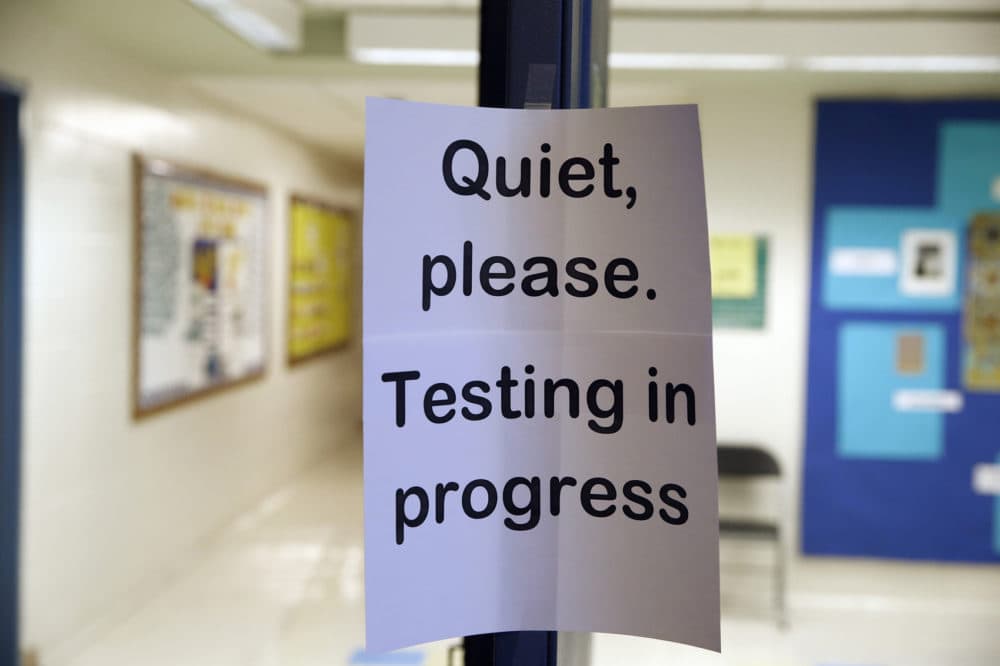Advertisement
Will An SAT 'Adversity Score' Actually Address College Admission Disadvantages?
Resume
Find our buildout from this hour, featuring a partial transcription, here.
With Meghna Chakrabarti
The College Board will add what it calls an "Environmental Context Dashboard" for everyone taking the SAT. Are you on board with the plan?
Guests
David Coleman, president and CEO of the College Board, a nonprofit known for designing and administering the SAT. (@CollegeBoard)
Thomas Chatterton Williams, national fellow at New America, a nonpartisan think tank. Contributing writer at The New York Times Magazine. Author of the forthcoming book, "Self-Portrait in Black and White: Unlearning Race." (@thomaschattwill)
Sheryll Cashin, professor of law, civil rights and social justice at the Georgetown University Law Center. Author of "Place, Not Race: A New Vision of Opportunity in America." (@sheryllcashin)
Mark Dunn, associate director of undergraduate admissions at Yale University. (@Yale)
From The Reading List
Wall Street Journal: "SAT to Give Students ‘Adversity Score’ to Capture Social and Economic Background" — "The College Board plans to assign an adversity score to every student who takes the SAT to try to capture their social and economic background, jumping into the debate raging over race and class in college admissions.
"This new number, called an adversity score by college admissions officers, is calculated using 15 factors including the crime rate and poverty levels from the student’s high school and neighborhood. Students won’t be told the scores, but colleges will see the numbers when reviewing their applications.
"Fifty colleges used the score last year as part of a beta test. The College Board plans to expand it to 150 institutions this fall, and then use it broadly the following year."
New York Times Magazine: "The SAT’s Bogus ‘Adversity Score’" — "Between my freshman and senior years of high school in the late ’90s, my father spent his evenings, weekends and vacations drilling my best friend and me for our SATs. My father was born black in the 1930s in the segregated South and became the first member of his family to go to college, let alone graduate school. These were lean years for my family, and my white mother had to return to work after decades as a homemaker. We just managed to rent a small house on the white side of our de facto segregated New Jersey suburb.
"My best friend, who was black and Puerto Rican and attended parochial school with me, commuted from a less affluent and more ethnically diverse neighborhood where his parents, who did not have graduate degrees and were divorced but frequently living together and pooling resources, were upwardly mobile homeowners. When the time came to take the test, I scored higher, though my friend did well enough to attend a selective four-year college, where he flourished, eventually moving on to the Ivy League and Wall Street. Both of us worked hard, had some advantages — namely highly supportive and involved parents — and were able to succeed despite being members of a historically oppressed demographic.
"I thought of those long hard hours studying at the dinner table when I heard on Thursday that the College Board, the company that administers the SAT, was appending an 'adversity index' to aptitude scores — essentially a handicap to standardize 'privilege.' "
The Atlantic: "The Problem With the SAT’s Idea of Objectivity" — "Students taking the SAT will soon be subjected to a new kind of assessment. On top of their math and verbal results, indicating what knowledge they were able to summon internally while taking the exam, they’ll be placed along a scale of adversity: a representation of the external. By calculating students’ social, economic, and family background, the College Board hopes to add new context to students’ test scores. Evaluating students on factors far beyond their control might seem like a novel attempt in leveling the playing field, but in some ways, it actually brings the test closer to its conflicted origins.
"The adversity index was first piloted by 10 colleges in 2017. It consists of 15 factors meant to approximate the degree of disadvantage a student has faced, including the crime rate in her neighborhood, the rigor of her high-school curriculum, and the estimated education level of her parents. Students don’t see their numbers, but admissions officers do, and have full discretion in whether or not to consider them when making admissions decisions. One of the pilot colleges, for example, only used the score when deciding whether to reevaluate an applicant it had initially rejected.
"Students report only the high school they attend and their address, and the College Board uses publicly available data to determine the scores from there. Crime rates, poverty rates, housing values, and the like are derived based on where students live. Family context, such as parents’ educational achievements, is based on averages in a student’s neighborhood."
Allison Pohle produced this show for broadcast.
This article was originally published on May 21, 2019.
This program aired on May 21, 2019.